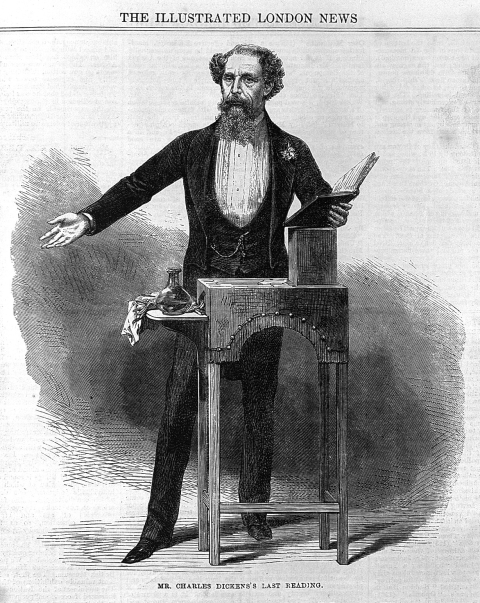
For two successive evenings, starting on the 24th May 1866, Charles Dickens returned to the town of his birth to give readings in the latest instalment of his wildly-popular national Reading Tours.
The venue for his readings was St. George’s Hall on St. George’s Square, Portsea. The hall no longer exists and in its place the unlovely Millgate House looms close by Gunwharf Quays.
Dickens had already included Portsmouth in his itinerary, performing at the same venue, on 11 November during his inaugural 1858 tour. It is impossible to understate the enormous excitement generated by Dickens’s decision to undertake reading tours, but this only grew once people began to experience the astonishing power of his performances: the Charles Dickens on Stage website offers some glimpses of how spellbound his audiences were, and why.
The most dramatic of authors
It’s worth underlining that the enormous impact of Dickens’s readings was not simply due to his unrivalled position as the pre-eminent author of his generation, but also to his incredible acting abilities. Dickens appeared in major theatricals throughout the 1850s, some private, but many in major theatres, and his performances were usually met with considerable acclaim – particularly his central role in The Frozen Deep, ostensibly written by Dickens’s friend and fellow novelist-performer, Wilkie Collins, and staged a number of times after its first outing in 1856.
It was during the national run of The Frozen Deep that Dickens encountered the actress Ellen (Nelly) Ternan, who was to become his mistress, and who is the subject of Claire Tomalin’s excellent 1990 study, The Invisible Woman, and a 2013 film of the same name starring Ralph Fiennes, Felicity Jones, and Kristen Scott-Thomas. This represents another major Portsmouth-Dickens connection. In 1910, many years after Dickens’s death, Ternan moved to Southsea and is buried in Highland Cemetery. The various Dickensian associations with the Cemetery are explored in the Portsmouth Literary Map as are his associations with St George’s Hall.
Exploring Dickens’s Portsmouth
Dickens’s associations with the city comprise a number of locations. He was born in Old Commercial Road and, largely because of his father’s debts, lived at a number of addresses in quick succession before moving with his family, aged three, for pastures new.
Although Dickens was not particularly drawn to the city, and returned infrequently, his visits sometimes included some typically Dickensian extended perambulations and high jinks. In Charles Dickens as I Knew Him (1912) George Dolby, the manager of Dickens’s reading tours, recorded that during the 1866 tour he, Dickens, and Dickens’s journalistic collaborator, William Henry Wills visited Dickens’s second home at Wish Street.
Dolby also records the following bizarre incident, amply demonstrating Dickens’s comedic and theatrical bent:
Readers interested in exploring the city’s many Dickensian locations can find more on the Portsmouth Literary Map (have a look at the entries under the Literary Figures (Deceased) and Literary Locations tabs), and there is also a walking tour pamphlet available from the excellent Charles Dickens Birthplace Museum.
The Farewell Tour
On a more melancholy note, it is worth underlining the strain that Dickens’s legendary Reading Tour performances placed on his health. So involved did he become in dramatizing his readings and captivating his eager audiences that the tours began to take their toll. In 1868 and 1869, he embarked on his final ‘Farewell Tours’, but was increasingly overtaken by giddiness and fits of paralysis. He suffered a stroke in Chester on 18 April 1869, and four days later, after collapsing in the aftermath of a 22 April 1869 engagement in Preston, he cancelled the tour.
Undaunted, he engaged for a further 11 performances in the summer of 1870, during which time he was also working on his final novel, The Mystery of Edwin Drood. His last performance took place before the Prince and Princess of Wales at a Royal Banquet on 2 May. Just over a month later, he suffered a final stroke, dying on 8 June 1870. He was laid to rest in Poet’s Corner, Westminster Abbey.
Mark Frost is a Senior Lecturer in English Literature and Map Director of the Portsmouth Literary Map.
Image credit: Charles Dickens (1812-1870) engraving. Copyright by Wellcome Images and cropped and shared under Creative Commons Attribution only licence.
